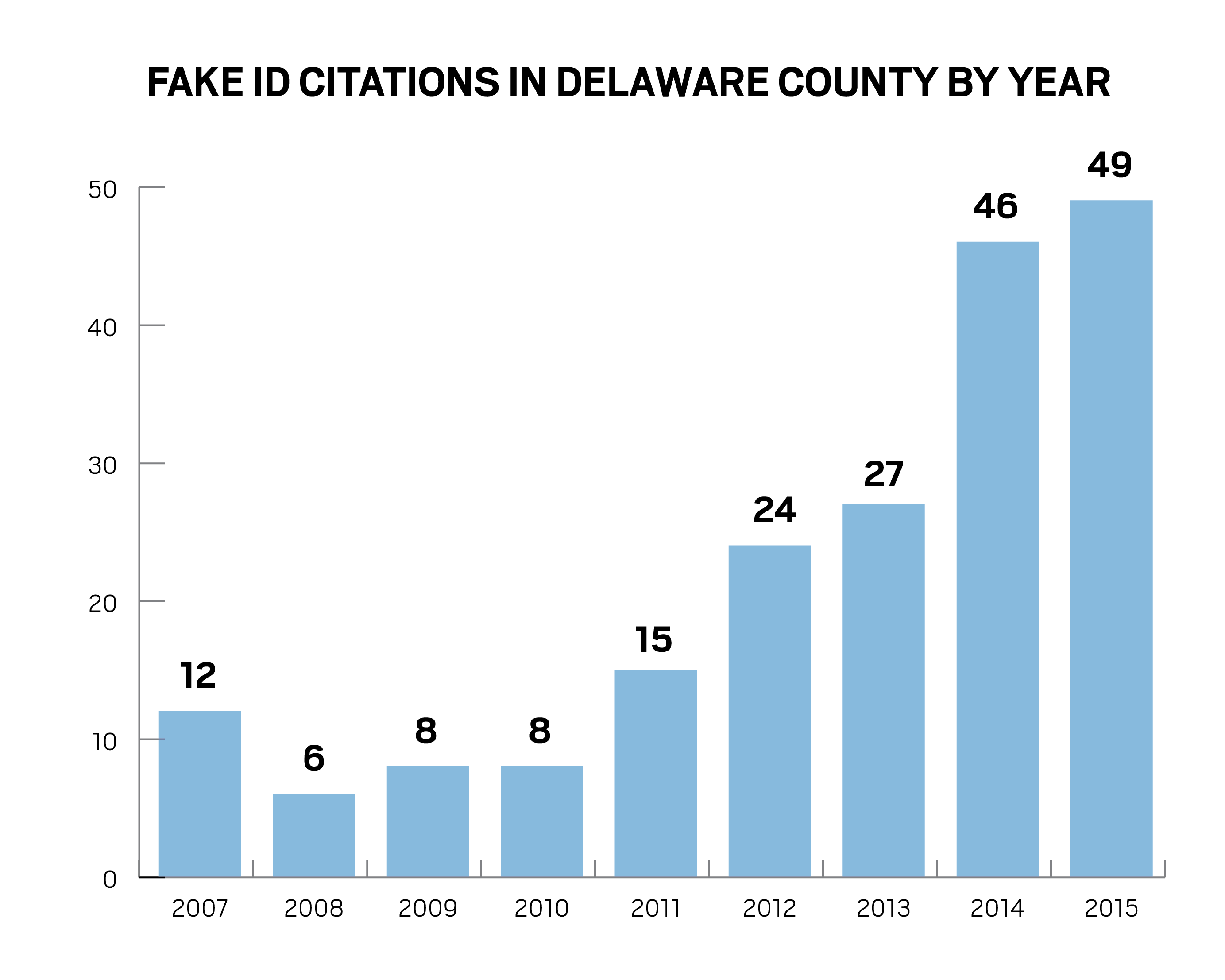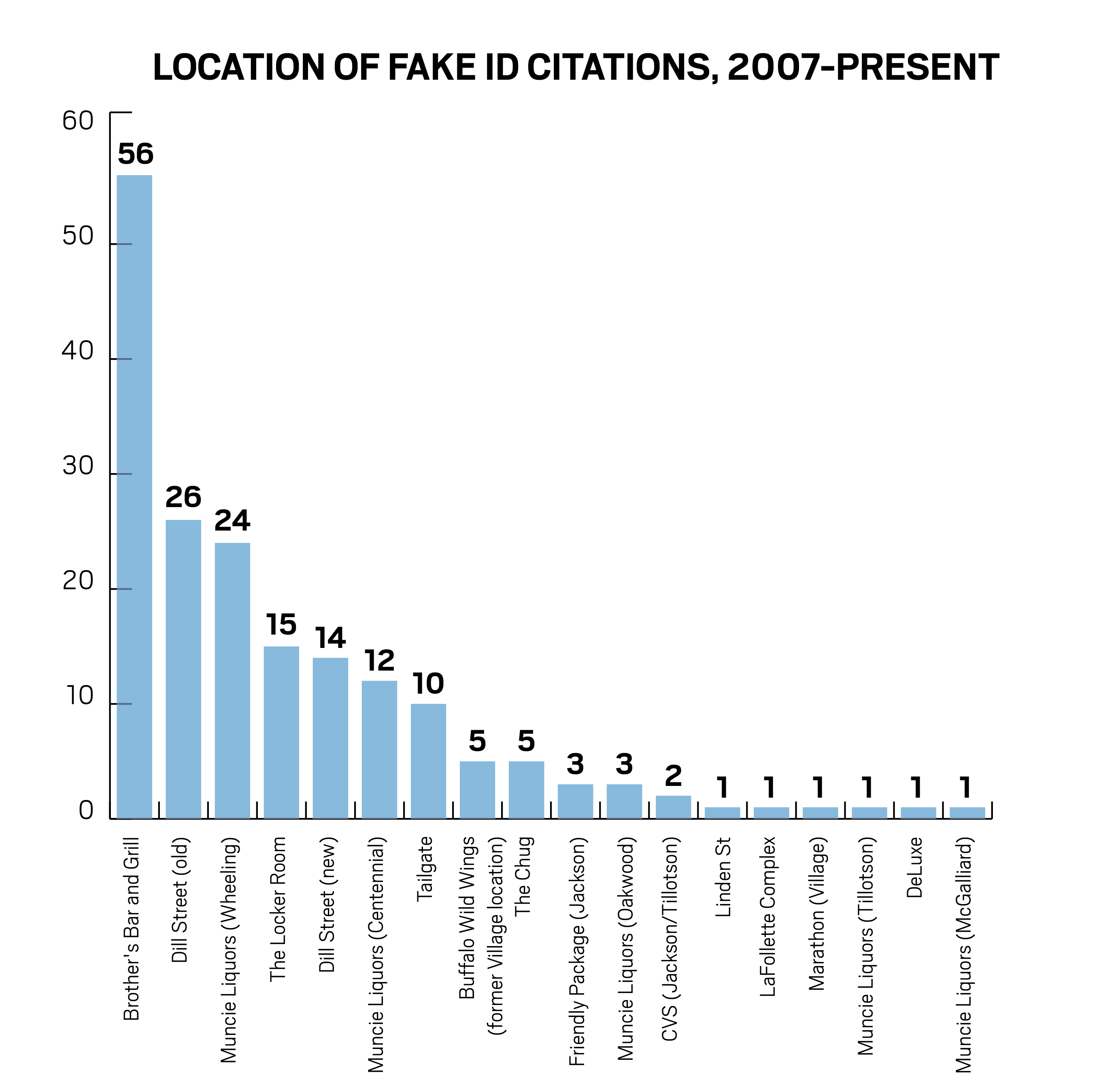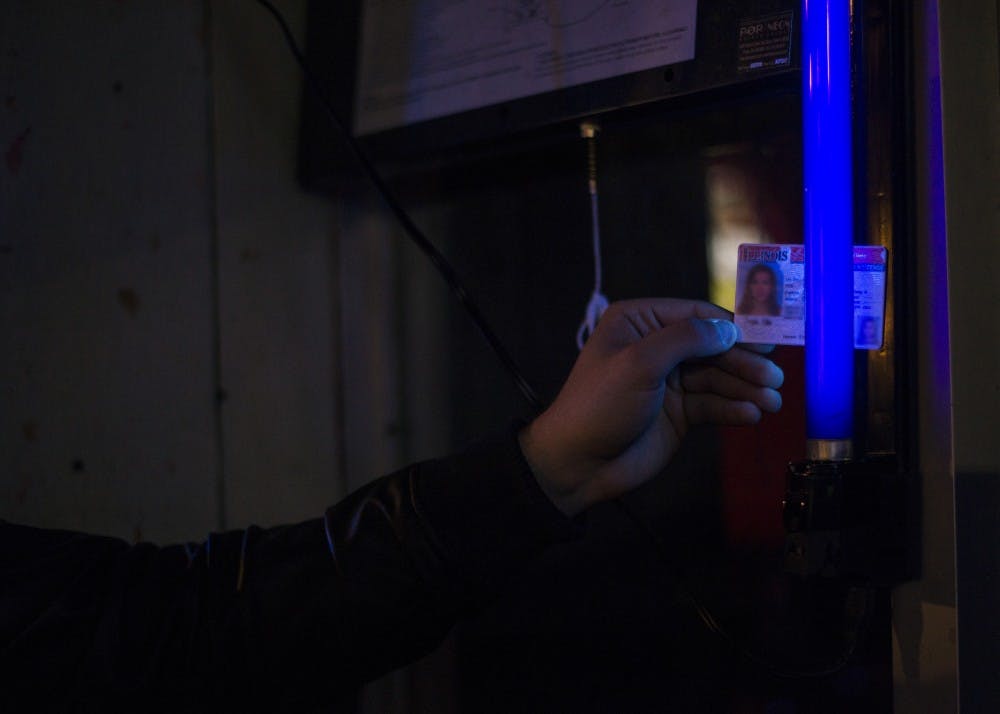Editor’s note: The names Caleb Johnson and Becca Braddock are pseudonymns. The students’ names were changed to protect their identity.
On the evening of Ball State's first tailgate, the CVS on Tillotson Avenue was quiet as Caleb Johnson• walked his half gallon of Svedka vodka to the cash register. He handed his ID to the older woman working.
“What's your address?” she asked after she peered at the card for what seemed like an eternity.
He told her.
“Your birth date?”
Again, an easy question. He had been using fake IDs since Christmas break to purchase alcohol from convenience and grocery stores.
“Your issue date?”
 Who even knows that? He guessed incorrectly and the worker refused to give the ID back to him. He walked back to his friend's car, empty handed.
Who even knows that? He guessed incorrectly and the worker refused to give the ID back to him. He walked back to his friend's car, empty handed.
He never received a citation, but he was out one of the two IDs he had spent $80 total to buy.
Indiana State Excise Police, the law enforcement division of the Alcohol and Tobacco Commission, gave out more citations related to fake or misused IDs in Muncie this past year than they have each year since they started using their data system in 2007, according to records from Indiana Excise Lieutenant Brandon Thomas.
It isn’t just Muncie that has experienced this increase. Police issued 1,073 citations in Indiana in 2015, which is double or nearly double the number of incidents every year except 2008.
Police are already on track to beat that number for 2016. There were 226 Indiana charges by Feb. 5 of this year, compared with only 57 in the same time period last year.
Those numbers don't even include people like Johnson, who were never given a citation.
The jump in the number of citations can, in part, be attributed to an increase in excise resources, Thomas said. The agency has been growing since 2006. Excise also received the Intensified College Enforcement (ICE) federal grant starting in 2012, which allowed the agency to use more manpower in college towns.

Another explanation for the overall increase is more people are buying fake IDs online, rather than just using someone else’s ID.
“Before, you had to know somebody in order to get them, somebody who was actually good at manufacturing IDs or had equipment,” Thomas said. “Now, they can just purchase them online over the internet for usually around $150 to $200.”
Johnson purchased his IDs on a website called idbook.ph, a company located outside of the United States.
Thomas said these sites are nearly impossible to shut down because they can’t be held to American laws. A few years ago, the federal government shut down one fake ID site, only to have it pop up with a different name later, Thomas said.
A big issue with these fake ID websites is they can often be scams. Becca Braddock*, a Ball State student, also used a fake ID before she turned 21. Although she purchased one from her sister her sophomore year, she originally tried buying one online.
But $100 later, she never received the fake IDs.
“I took the picture, sent them my signature, and I never got anything back,” Braddock said. “I would always check in LaFollette in my mailbox. I was literally 18 years old. I was so stupid.”
‘It’s just so simple.’
After handling IDs every night he works, Como Negrete, a senior accounting major, said it's easy to tell which ones are fake.
Negrete has been working as a door host, or bouncer, at The Chug since May 2015.
He said the easiest ones to catch are those who use hand-me-down IDs.
“That's a lot easier to catch because a lot of [bouncers] know older people,” Negrete said. “So we're just like, ‘We know this person, and it's not you.’ It's just so simple.”
One tactic Negrete uses is to ask a friend of the person with the fake ID what their friend’s “name” is. Oftentimes, the friends don't know and give it away.
Bouncers can also weed out some people by asking for a second form of identification.
He also said it's easy to spot fake IDs purchased online. Every bouncer is trained to spot signs an ID is fake using a book of licenses from every state.
What the bouncers look for varies by state. Fake Ohio IDs, for example, often don't have the class or restrictions on the back of the ID like normal cards do.
Seeing uncommon states like Connecticut or Rhode Island is also a red flag. Other states, like Michigan, are rarely faked because the material is often too flimsy to properly duplicate.
On a batch of recent Ohio and Illinois fakes, the faces looked photo shopped onto the background.
Bouncers also use black lights to check ultraviolet pictures hidden on the card — something fake ID companies often leave off. On some of the Ohio fakes, the hologram is even a picture of a smiley face, said Phil Juskevice, the general manager of The Chug.
Juskevice has been around the Muncie bar scene for the past 14 years, starting out with his job as a bouncer at Scotty's Brewhouse when he was 21.
“People don't understand that when you see these on a regular basis, they're pretty easy to pick out,” Juskevice said. “I'll be honest — for the life of me, I don't understand why people, when they make fake IDs, don't make them better.”
Excise also provides some help by going to bars on weekends, dressed as normal students. They often sit by the door and watch the bouncers card people, or they card people themselves.
Although they don’t always tell bar managers they will be in town, Juskevice can usually tell who the excise police are.
He also said they go to other bars like Brothers Bar & Grill more often. As a result, excise has issued more fake ID-related citations at Brothers Bar & Grill than at any other bar since 2007, despite its more recent 2014 opening date. Police have issued more than double the citations at Brothers than the bar with the second-most citations, the late Dill Street.
Not only does excise randomly stop by bars and liquor stores throughout the state, but it also updates the stores and restaurants on the latest fake ID trends.
In January, batches of Kentucky and Pennsylvania fake IDs were frequently used, Negrete said. Typically, Ohio and Illinois are faked the most often.
Despite all the methods bouncers can use to determine whether an ID is real or fake — and the large number of citations excise gives out — underage students still get into the bars.
While Johnson never used his fake ID to get into Muncie bars, Braddock used her older sister's ID nearly every weekend when she was 20. She got into both Brothers Bar & Grill and The Chug, she said.
“I feel like that is a potential problem everywhere,” Juskevice said, responding to the claim. “You're dealing with the human aspect of it too. My hope is that we're catching as many as possible.”
Muncie’s Brothers Bar & Grill turned down an interview with the Daily News on the topic.

‘It all falls back on me.’
People can often get away without any charges for using a fake ID. However, if excise is present, or stores and bars turn a person in to excise, the fines can add up.
The most common charge is possession of a false ID. This is a Class C Infraction, which would result in fines similar to that of a speeding ticket. Another common charge is misrepresentation of age, a Class C Misdemeanor which could result in 60 days in jail or a $500 fine.
Bars, stores and restaurants are allowed to confiscate an ID if they think it's fake. Thomas said the common myth that bars can’t take IDs because it’s an individual’s property is false.
Despite the fear of getting caught, both Braddock and Johnson said getting a fake ID was worth it.
“It was very convenient getting alcohol myself and not having to count on somebody, and I did that a decent amount,” Johnson said. “I had fun using it. I'd do it again.”
Bars are held liable if they let minors drink and something goes wrong. They can either be charged with furnishing alcohol to a minor or allowing a minor to order in an establishment. Thomas said the fines can be steep.
When Thomas was working in Goshen a few years ago, a minor crashed into a tree and died after drinking at a local bar. Though he doesn't remember the exact outcome of the case, the bar faced the possible revocation of its liquor permit.
People don’t often think about how using a fake ID can impact bar owners, who could face serious consequences for allowing underage drinking, Juskevice said.
“I have a wife and a child. If excise comes down here and [they catch] underage drinking, it all falls back on me,” Juskevice said. “This is how I and many other people, not just here, make their living. This is how they support families and themselves.
Still, Juskevice acknowledges people do drink before they're 21, and he has acquaintances who use fakes elsewhere, though they stay away from his bar.
Using a fake is just normal, Braddock said.
“Honestly, I'll go to the bar and, at this point, I won't even know who's 21 and who is not 21,” Braddock said. “I won't even blink when I see one of my friends out that aren't 21.”



